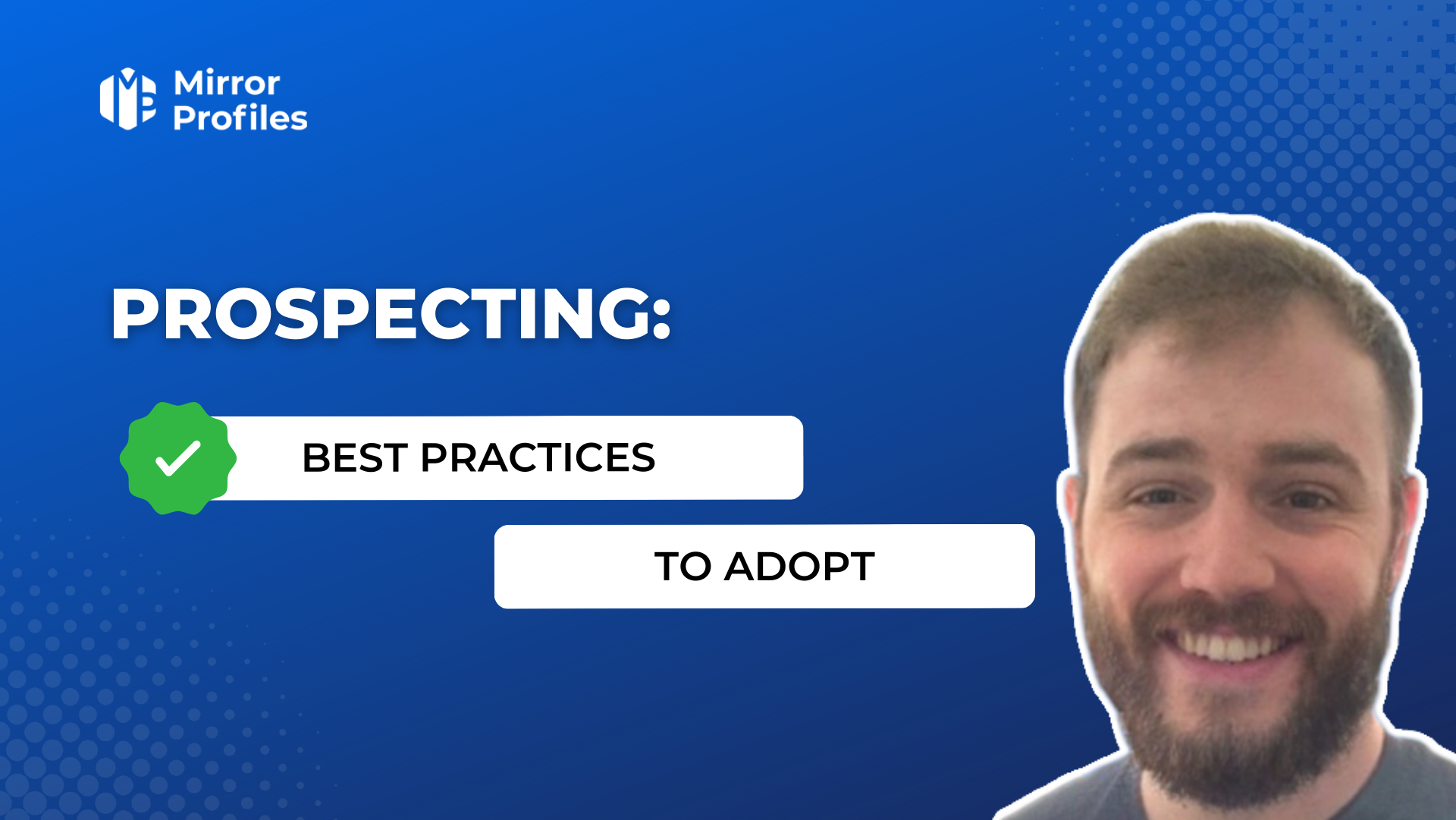Introduction
Sales prospecting is crucial for any company wishing to grow its business. Whether you’re an SME or a major corporation, this approach is essential for expanding your customer base. But what are the best methods for effective prospecting? What actions and tips can you adopt to succeed?
This guide is designed to teach you the solid basics of sales prospecting, show you the most effective contact strategies for your audience, point you in the direction of the most successful prospecting channels, and suggest the tools that will enhance your approach. You’ll learn how to set up a structured prospecting plan focused on your growth objectives and customer relationship maintenance.
Whether you have extensive sales experience or are just starting out, this content is your passport to excellence in sales prospecting. Conquering new business horizons? Let our expert advice be your guide!
Understand the fundamentals of effective sales prospecting
To succeed in sales prospecting, grasp the essential principles to ensure greater success. There are two critical phases: determining and segmenting the target market, and setting clear, quantifiable objectives. When it comes to prospecting, every detail counts. And let’s not forget the secret ingredient without which nothing happens: trust. If you’re not sure whether your product/service meets your customer’s needs. It won’t work. A sales person isn’t there to sell, he’s there to solve a need. Once you’ve understood this, your business will continue to grow.
Identify and segment your target market
Identifying the right people or companies to contact is essential. Instead of prospecting blindly, target those who have a real need or interest in what you offer. Careful market research will reveal the characteristics, expectations, motivations and obstacles of your target audience, enabling you to tailor your offer and communication to each prospect’s profile. In the field of sales prospecting, this in-depth knowledge is crucial. Depending on your product or service, it’s sometimes best to try and sell your solution before it exists. It’s the same principle as in science, when you take a representative sample. Take a hundred people who correspond to your target. If 10% are interested, that’s good. If 1% are ready to pull out their bank cards as soon as your price is announced, you’re good to go. No need for academic market research. Keep in mind that it’s your customers who make (and un-make) your product/service.
Segmentation is the second phase, where you divide your market into homogeneous groups, based on criteria such as geography, demographics or behavior. Well-defined segments will help you personalize your approach and maximize your chances of conversion in the field.
Set clear, measurable objectives
It’s crucial to define precise goals for your sales approach. Rather than setting vague or impossible objectives, base your decisions on factual data. The SMART method helps here: your goals must be Specific, Measurable, Attainable, Realistic and Time-bound. For example, aim to contact 100 prospects per week, obtain 20 appointments, and close 10 transactions. Depending on your ambitions, you may need the help of tools to help you achieve your goals. For example, with MirrorProfiles, you can contact hundreds of people a week on Linkedin.
Setting objectives will structure your prospecting, make it easier to monitor your performance, help you adjust your aim if necessary, and stimulate you to achieve your ambitions.
Contact strategies: decisive first steps
To get off to a good start, first identify your target audience and clarify your objectives. Then it’s time to start talking to potential customers. This initial phase is fundamental, as it shapes the future of your business relationship. Are you wondering how best to approach a prospect? Wondering how to behave? Here are three essential recommendations for fine-tuning your approach techniques.
First contact: create a high-performance call or message script
When you opt for telephone prospecting, e-mail or social platforms as your communication channels, it’s crucial to fine-tune your first message. Writing a precise script for your calls or messages can serve as an effective cue, helping you to present your product or service and capture your prospect’s attention. Your script should be direct, succinct, engaging and personalized to your audience. Include a compelling hook, a presentation of the offer, a unique value proposition, pre-emptive rebuttal of potential objections, and conclude with an inciting call to action. If you decide to make your first approach via Linkedin, I recommend you read our article on the 10 golden rules to follow in your Linkedin prospecting messages.
Personalized approach: the key to differentiation
Afin de vous distinguer dans un marché concurrentiel et face à des prospects constamment sollicités, la personnalisation est votre alliée. Build a bridge of trust by adapting your approach to your target’s specific needs and expectations, taking into account their motivations and possible resistance. Find out about the prospect’s personal situation, relevant news and interests, and what brings you closer to them. An automated approach message designed to pre-qualify you is the best strategy, so don’t try to sell on the first message. Then your personalized response to his concerns will make all the difference.
The importance of CRM for optimal prospect management
Efficient prospect management requires the use of specialized tools. CRM (Customer Relationship Management) is the ideal software for gathering and organizing your customer data. It will enable you to track the progress of your contacts and analyze the impact of your prospecting efforts. Thanks to this system, you can not only save time by automating certain operations, but also improve your communication, build customer loyalty and boost your sales.
To find out more about the best tools to use for all your sales prospecting, we’ve selected for you the 10 tools to boost your sales prospecting.
Adopt the right prospecting channels
The key to effective sales prospecting lies in choosing the right channels for your target audience, your offer and your budget. We’ll be focusing on the three main prospecting channels: digital, telephone, physical and content marketing.
Digital prospecting: email, social networks and SEO
Digital technology is now essential in the world of sales prospecting. It offers extended reach, helps minimize costs, facilitates performance monitoring and contributes to customer loyalty. The most popular digital tools include emailing, social networking and search engine optimization (SEO).
Email marketing is a direct, personalized, high-performance communication medium. It allows you to reach your prospects, introduce them to your proposal, follow up and encourage them to take action. To optimize your email prospecting campaigns, it’s essential to use a relevant database, carefully craft your email subject lines, create engaging content with an attractive design and integrate an explicit call to action.
Social networks are the ideal place to develop an engaged community around your brand or services. They strengthen your online presence, drive traffic to your site, collect feedback, build relationships and foster loyalty. A successful network sales strategy involves choosing the right platforms for your audience, creating attractive profiles, publishing relevant content and interacting with your prospects. When you’re in B2B, Linkedin is essential. Having optimized, prospecting Linkedin profiles will help boost your visibility in the medium to long term, as well as generating leads in the short term.
SEO, which involves improving your site’s search engine positioning, attracts quality traffic to your site, draws prospects looking for solutions and facilitates their conversion into customers. To do this, focus on the quality of your content, the technical aspects of your site, and its popularity.
Telephone and physical prospecting: when and how to use them
Despite their traditional nature, telephone and physical prospecting remain highly relevant for certain market segments, especially when the aim is to increase sales. They enable direct, personalized contact, a lively presentation of your offers, a reaction to objections, and are more convincing.
Telephone prospecting, which involves contacting prospects by phone with specific intentions such as an appointment or a sales proposal, requires rigorous preparation with a script, targeted selection of prospects, optimal call timing, a positive attitude and concluding with a well-defined call to action. Here, your salesperson’s morale will play a key role in sales success. So don’t set your targets too high: an experienced salesperson will be able to make 20/30 good calls a day. Automate everything you can: the call must be triggered on prospects at the end of the acquisition funnel.
Face-to-face sales prospecting, on the other hand, can take place at scheduled meetings, trade shows or events, all of which provide opportunities to boost sales. To take advantage of this, you need to prepare your pitch well, adjust your sales pitch to suit the person you’re talking to, use engaging visual tools, listen actively and propose tailor-made solutions.
Content marketing: attracting prospects through added value to drive sales
Content marketing is about producing and sharing useful information that brings real added value to your audience. This approach establishes your credibility as an expert, piques curiosity, earns prospects’ trust, educates them and guides them through the decision-making process.
Various formats can be exploited, such as blog articles, e-books, webinars, podcasts, videos or infographics. For an effective content strategy, you need to clearly define your objectives, know your audience well, select appropriate formats, produce attractive content and share it on the most appropriate channels.
Conclusion
Successful sales prospecting is essential to increase sales and strengthen customer loyalty. Here are the best practices to adopt to achieve this:
- Quality databases: it’s crucial to accurately identify and segment your target market, while defining precise, quantifiable objectives.
- Improved contact strategies: develop compelling call or message scripts, personalize your approach and use customer relationship management (CRM) software to optimize prospect follow-up.
- Selecting the right prospecting channels: take advantage of digital tools (emailing, social networks, SEO), as well as telephone contact and face-to-face meetings, not forgetting content marketing, to maximize your sales.
By implementing these recommendations, you’ll be able to develop an effective sales prospecting plan that will help you explore new markets and boost your business.
FAQ
How do you prospect effectively?
For successful sales prospecting, start by drawing up a strategic plan that identifies your objectives, determines your target audience, selects the most appropriate communication channels and develops the content of the message to be conveyed. After that, get in touch with your potential prospects, assess their potential, meet a need and work to turn them into loyal customers. A salesperson is not there to sell, but to solve a need among your prospects.
What does commercial prospecting involve?
Sales prospecting is an active process used by companies to seek out and attract new customers (prospects) who might be attracted to their products or services. This approach can be proactive, through direct contact with prospects, or reactive, by attracting customers through engaging content and digital marketing techniques.
What are the various prospecting methods?
There are various prospecting methods, each adapted to specific objectives and contexts. Some of the most commonly used techniques include: field sales, telephone calls, email marketing, indirect approaches, social selling, SMS campaigns and trade show participation.
What’s the best way to prospect a customer?
To prospect effectively with a customer, it’s crucial to start by identifying and qualifying prospects who are adaptable to what you have to offer. Then choose the communication channels that best match their profile and needs. Prepare a convincing sales pitch, anticipate possible resistance and be ready to close the sale in good time.




